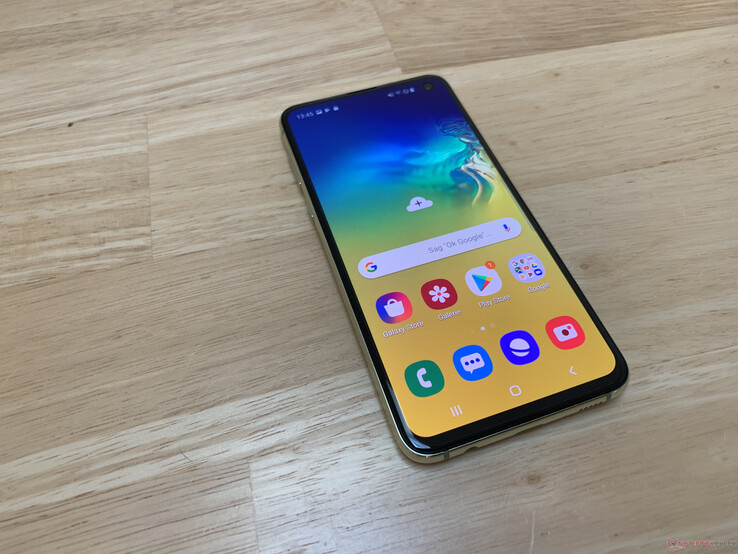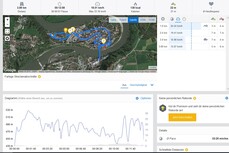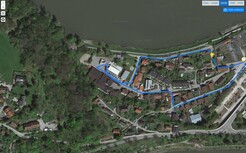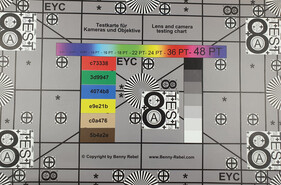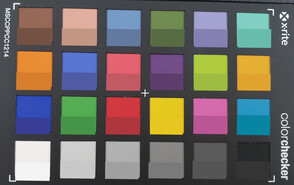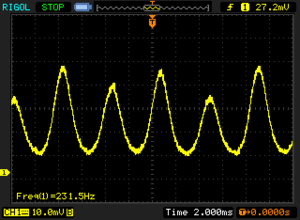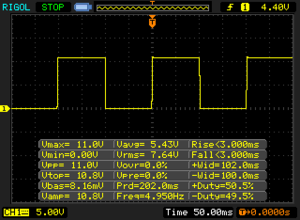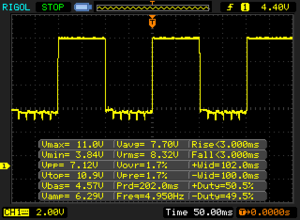三星Galaxy S10e智能手机评测
| Networking | |
| iperf3 transmit AX12 | |
| Apple iPhone XR | |
| Samsung Galaxy S10 | |
| OnePlus 6T | |
| Samsung Galaxy S10e | |
| Samsung Galaxy S10 Plus | |
| Honor View 20 | |
| iperf3 receive AX12 | |
| Samsung Galaxy S10 | |
| Samsung Galaxy S10 Plus | |
| OnePlus 6T | |
| Samsung Galaxy S10e | |
| Apple iPhone XR | |
| Honor View 20 | |
» Notebookcheck多媒体笔记本电脑Top 10排名
» Notebookcheck游戏笔记本电脑Top 10排名
» Notebookcheck低价办公/商务笔记本电脑Top 10排名
» Notebookcheck高端办公/商务笔记本电脑Top 10排名
» Notebookcheck工作站笔记本电脑Top 10排名
» Notebookcheck亚笔记本电脑Top 10排名
» Notebookcheck超级本产品Top 10排名
» Notebookcheck变形本产品Top 10排名
» Notebookcheck平板电脑Top 10排名
» Notebookcheck智能手机Top 10排名
» Notebookcheck评测过最出色的笔记本电脑屏幕
» Notebookcheck售价500欧元以下笔记本电脑Top 10排名
» Notebookcheck售价300欧元以下笔记本电脑Top 10排名
| |||||||||||||||||||||||||
Brightness Distribution: 96 %
Center on Battery: 426 cd/m²
Contrast: ∞:1 (Black: 0 cd/m²)
ΔE ColorChecker Calman: 2.14 | ∀{0.5-29.43 Ø4.78}
ΔE Greyscale Calman: 1.8 | ∀{0.09-98 Ø5}
97.5% sRGB (Calman 2D)
Gamma: 2.111
CCT: 6329 K
| Samsung Galaxy S10e AMOLED, 2280x1080, 5.8" | OnePlus 6T Optic AMOLED, 2340x1080, 6.4" | Honor View 20 LTPS, 2310x1080, 6.4" | Samsung Galaxy S10 OLED, 3040x1440, 6.1" | Samsung Galaxy S10 Plus OLED, 3040x1440, 6.4" | Apple iPhone XR IPS, 1792x828, 6.1" | |
|---|---|---|---|---|---|---|
| Screen | -7% | -21% | -22% | -22% | 23% | |
| Brightness middle (cd/m²) | 426 | 437 3% | 492 15% | 701 65% | 710 67% | 672 58% |
| Brightness (cd/m²) | 427 | 442 4% | 475 11% | 705 65% | 721 69% | 641 50% |
| Brightness Distribution (%) | 96 | 95 -1% | 94 -2% | 98 2% | 97 1% | 92 -4% |
| Black Level * (cd/m²) | 0.4 | 0.35 | ||||
| Colorchecker dE 2000 * | 2.14 | 2.21 -3% | 2.4 -12% | 3.7 -73% | 3.7 -73% | 1.3 39% |
| Colorchecker dE 2000 max. * | 3.29 | 4.27 -30% | 5.2 -58% | 10.3 -213% | 10.3 -213% | 2.7 18% |
| Greyscale dE 2000 * | 1.8 | 2.1 -17% | 3.2 -78% | 1.4 22% | 1.5 17% | 2.2 -22% |
| Gamma | 2.111 104% | 2.307 95% | 2.06 107% | 2.1 105% | 2.1 105% | 2.3 96% |
| CCT | 6329 103% | 6353 102% | 7125 91% | 6553 99% | 6611 98% | 6868 95% |
| Contrast (:1) | 1230 | 1920 |
* ... smaller is better
Screen Flickering / PWM (Pulse-Width Modulation)
| Screen flickering / PWM detected | 232 Hz | ||
The display backlight flickers at 232 Hz (worst case, e.g., utilizing PWM) . The frequency of 232 Hz is relatively low, so sensitive users will likely notice flickering and experience eyestrain at the stated brightness setting and below. In comparison: 53 % of all tested devices do not use PWM to dim the display. If PWM was detected, an average of 8098 (minimum: 5 - maximum: 343500) Hz was measured. | |||
Display Response Times
| ↔ Response Time Black to White | ||
|---|---|---|
| 6 ms ... rise ↗ and fall ↘ combined | ↗ 3 ms rise | |
| ↘ 3 ms fall | ||
| The screen shows very fast response rates in our tests and should be very well suited for fast-paced gaming. In comparison, all tested devices range from 0.1 (minimum) to 240 (maximum) ms. » 17 % of all devices are better. This means that the measured response time is better than the average of all tested devices (20.2 ms). | ||
| ↔ Response Time 50% Grey to 80% Grey | ||
| 6 ms ... rise ↗ and fall ↘ combined | ↗ 3 ms rise | |
| ↘ 3 ms fall | ||
| The screen shows very fast response rates in our tests and should be very well suited for fast-paced gaming. In comparison, all tested devices range from 0.165 (minimum) to 636 (maximum) ms. » 17 % of all devices are better. This means that the measured response time is better than the average of all tested devices (31.6 ms). | ||
| PCMark for Android | |
| Work performance score (sort by value) | |
| Samsung Galaxy S10e | |
| OnePlus 6T | |
| Honor View 20 | |
| Samsung Galaxy S10 | |
| Samsung Galaxy S10 Plus | |
| Average Samsung Exynos 9820 (9557 - 10008, n=4) | |
| Work 2.0 performance score (sort by value) | |
| Samsung Galaxy S10e | |
| OnePlus 6T | |
| Honor View 20 | |
| Samsung Galaxy S10 | |
| Samsung Galaxy S10 Plus | |
| Average Samsung Exynos 9820 (7595 - 7966, n=4) | |
| Basemark GPU 1.1 | |
| 1920x1080 Vulkan Medium Offscreen (sort by value) | |
| Samsung Galaxy S10e | |
| OnePlus 6T | |
| Samsung Galaxy S10 | |
| Samsung Galaxy S10 Plus | |
| Average Samsung Exynos 9820 (38.4 - 38.6, n=3) | |
| Vulkan Medium Native (sort by value) | |
| Samsung Galaxy S10e | |
| OnePlus 6T | |
| Samsung Galaxy S10 | |
| Samsung Galaxy S10 Plus | |
| Average Samsung Exynos 9820 (27.2 - 36.2, n=3) | |
| 1920x1080 OpenGL Medium Offscreen (sort by value) | |
| Samsung Galaxy S10e | |
| OnePlus 6T | |
| Samsung Galaxy S10 | |
| Samsung Galaxy S10 Plus | |
| Average Samsung Exynos 9820 (32.3 - 33, n=3) | |
| AnTuTu v7 - Total Score (sort by value) | |
| Samsung Galaxy S10e | |
| OnePlus 6T | |
| Honor View 20 | |
| Samsung Galaxy S10 | |
| Samsung Galaxy S10 Plus | |
| Average Samsung Exynos 9820 (327454 - 333277, n=4) | |
| AnTuTu v6 - Total Score (sort by value) | |
| Samsung Galaxy S10e | |
| OnePlus 6T | |
| Honor View 20 | |
| Samsung Galaxy S10 | |
| Samsung Galaxy S10 Plus | |
| Average Samsung Exynos 9820 (269219 - 283270, n=4) | |
| VRMark - Amber Room (sort by value) | |
| OnePlus 6T | |
| Samsung Galaxy S10 Plus | |
| Average Samsung Exynos 9820 (n=1) | |
| Basemark ES 3.1 / Metal - offscreen Overall Score (sort by value) | |
| Samsung Galaxy S10e | |
| OnePlus 6T | |
| Samsung Galaxy S10 | |
| Samsung Galaxy S10 Plus | |
| Apple iPhone XR | |
| Average Samsung Exynos 9820 (1927 - 1937, n=3) | |
| Average of class Smartphone (205 - 7731, n=35, last 2 years) | |
| Octane V2 - Total Score | |
| Average of class Smartphone (2228 - 121337, n=197, last 2 years) | |
| Apple iPhone XR (Safari Mobile 12.0) | |
| Honor View 20 (Chrome 71) | |
| Samsung Galaxy S10 Plus (Samsung Browser 9.0) | |
| Samsung Galaxy S10 (Samsung Browser 9.0) | |
| Average Samsung Exynos 9820 (18697 - 20849, n=4) | |
| Samsung Galaxy S10e (Chrome 73) | |
| OnePlus 6T (Chrome 70) | |
| Mozilla Kraken 1.1 - Total | |
| OnePlus 6T (Chrome 70) | |
| Samsung Galaxy S10e (Chrome 73) | |
| Honor View 20 (Chrome 71) | |
| Average Samsung Exynos 9820 (1823 - 2240, n=4) | |
| Samsung Galaxy S10 (Samsung Browser 9.0) | |
| Samsung Galaxy S10 Plus (Samsung Browser 9.0) | |
| Average of class Smartphone (257 - 28190, n=154, last 2 years) | |
| Apple iPhone XR (Safari Mobile 12.0) | |
| WebXPRT 3 - Overall | |
| Average of class Smartphone (38 - 380, n=31, last 2 years) | |
| Apple iPhone XR (Safari Mobile 12.0) | |
| Samsung Galaxy S10 Plus (Samsung Browser 9.0) | |
| Average Samsung Exynos 9820 (115 - 115, n=2) | |
| Honor View 20 (Chrome 71) | |
| WebXPRT 2015 - Overall | |
| Apple iPhone XR (Safari Mobile 12.0) | |
| Samsung Galaxy S10 (Samsung Browser 9.0) | |
| Samsung Galaxy S10 Plus (Samsung Browser 9.0) | |
| Average Samsung Exynos 9820 (292 - 325, n=3) | |
| Samsung Galaxy S10e (Chrome 73) | |
| Honor View 20 (Chrome 71) | |
| OnePlus 6T (Chrome 70) | |
* ... smaller is better
| Samsung Galaxy S10e | OnePlus 6T | Honor View 20 | Samsung Galaxy S10 | Samsung Galaxy S10 Plus | Apple iPhone XR | Average 128 GB UFS 2.1 Flash | Average of class Smartphone | |
|---|---|---|---|---|---|---|---|---|
| AndroBench 3-5 | -3% | 134% | 3% | 4% | 84% | 615% | ||
| Sequential Read 256KB (MB/s) | 792 | 735 -7% | 847 7% | 832 5% | 811 2% | 761 ? -4% | 2228 ? 181% | |
| Sequential Write 256KB (MB/s) | 194.1 | 204.4 5% | 250.1 29% | 193.2 0% | 249.1 28% | 296 ? 52% | 1852 ? 854% | |
| Random Read 4KB (MB/s) | 136.9 | 138.5 1% | 168.9 23% | 137.4 0% | 135.2 -1% | 154 ? 12% | 296 ? 116% | |
| Random Write 4KB (MB/s) | 24.1 | 22 -9% | 138.9 476% | 24.44 1% | 22.7 -6% | 130.4 ? 441% | 339 ? 1307% | |
| Sequential Read 256KB SDCard (MB/s) | 73.2 ? | 77.9 ? 6% | 73 ? 0% | 76 ? 4% | ||||
| Sequential Write 256KB SDCard (MB/s) | 60.7 ? | 64.8 ? 7% | 60.7 ? 0% | 59.6 ? -2% |
(-) The maximum temperature on the upper side is 47.1 °C / 117 F, compared to the average of 35.2 °C / 95 F, ranging from 21.9 to 247 °C for the class Smartphone.
(-) The bottom heats up to a maximum of 45.6 °C / 114 F, compared to the average of 34 °C / 93 F
(±) In idle usage, the average temperature for the upper side is 34.4 °C / 94 F, compared to the device average of 32.9 °C / 91 F.
Samsung Galaxy S10e audio analysis
(+) | speakers can play relatively loud (83 dB)
Bass 100 - 315 Hz
(-) | nearly no bass - on average 69.2% lower than median
(+) | bass is linear (0% delta to prev. frequency)
Mids 400 - 2000 Hz
(-) | nearly no mids - on average 69.2% lower than median
(+) | mids are linear (0% delta to prev. frequency)
Highs 2 - 16 kHz
(-) | nearly no highs - on average 69.2% lower than median
(+) | highs are linear (0% delta to prev. frequency)
Overall 100 - 16.000 Hz
(-) | overall sound is not linear (121.7% difference to median)
Compared to same class
» 90% of all tested devices in this class were better, 8% similar, 2% worse
» The best had a delta of 11%, average was 35%, worst was 134%
Compared to all devices tested
» 97% of all tested devices were better, 2% similar, 1% worse
» The best had a delta of 4%, average was 24%, worst was 134%
Samsung Galaxy S10 audio analysis
(+) | speakers can play relatively loud (88 dB)
Bass 100 - 315 Hz
(-) | nearly no bass - on average 23.8% lower than median
(±) | linearity of bass is average (11.4% delta to prev. frequency)
Mids 400 - 2000 Hz
(+) | balanced mids - only 3.7% away from median
(+) | mids are linear (4.2% delta to prev. frequency)
Highs 2 - 16 kHz
(±) | higher highs - on average 5.7% higher than median
(+) | highs are linear (4.4% delta to prev. frequency)
Overall 100 - 16.000 Hz
(±) | linearity of overall sound is average (18.3% difference to median)
Compared to same class
» 18% of all tested devices in this class were better, 9% similar, 73% worse
» The best had a delta of 11%, average was 35%, worst was 134%
Compared to all devices tested
» 39% of all tested devices were better, 8% similar, 53% worse
» The best had a delta of 4%, average was 24%, worst was 134%
| Off / Standby | |
| Idle | |
| Load |
|
Key:
min: | |
| Samsung Galaxy S10e 3100 mAh | OnePlus 6T 3700 mAh | Honor View 20 4000 mAh | Samsung Galaxy S10 3400 mAh | Samsung Galaxy S10 Plus 4100 mAh | Apple iPhone XR 2942 mAh | Average Samsung Exynos 9820 | Average of class Smartphone | |
|---|---|---|---|---|---|---|---|---|
| Power Consumption | -2% | -48% | 0% | -19% | -28% | -9% | -23% | |
| Idle Minimum * (Watt) | 0.6 | 0.7 -17% | 0.97 -62% | 0.61 -2% | 0.73 -22% | 0.61 -2% | 0.65 ? -8% | 0.842 ? -40% |
| Idle Average * (Watt) | 1.2 | 1.1 8% | 2.58 -115% | 1.27 -6% | 1.53 -28% | 2.67 -123% | 1.455 ? -21% | 1.439 ? -20% |
| Idle Maximum * (Watt) | 1.5 | 2.1 -40% | 2.63 -75% | 1.3 13% | 2.07 -38% | 2.69 -79% | 1.675 ? -12% | 1.624 ? -8% |
| Load Average * (Watt) | 5.2 | 4.2 19% | 5.24 -1% | 6.17 -19% | 6.03 -16% | 4.34 17% | 5.88 ? -13% | 7.03 ? -35% |
| Load Maximum * (Watt) | 10.2 | 8.3 19% | 8.73 14% | 8.55 16% | 9.18 10% | 5.66 45% | 9.44 ? 7% | 11.3 ? -11% |
* ... smaller is better
| Samsung Galaxy S10e 3100 mAh | OnePlus 6T 3700 mAh | Honor View 20 4000 mAh | Samsung Galaxy S10 3400 mAh | Samsung Galaxy S10 Plus 4100 mAh | Apple iPhone XR 2942 mAh | |
|---|---|---|---|---|---|---|
| Battery runtime | 62% | 63% | 5% | 20% | 91% | |
| Reader / Idle (h) | 19.8 | 32.3 63% | 32.1 62% | 21 6% | 26 31% | 49.5 150% |
| H.264 (h) | 13.3 | 15.1 14% | 15.5 17% | 14 5% | 15.4 16% | 16.9 27% |
| WiFi v1.3 (h) | 6.9 | 14.4 109% | 16.2 135% | 7.1 3% | 8.1 17% | 15.2 120% |
| Load (h) | 2.7 | 4.4 63% | 3.7 37% | 2.8 4% | 3.1 15% | 4.5 67% |
Pros
Cons
三星Galaxy S10e是一款一流的智能手机,比更昂贵的Galaxy S10或S10+更值得考虑。不过还是有一些妥协,例如缺少第三个后置摄像头,没有陶瓷背板,但你仍然可以获得耳机插孔,高速LTE,强大SoC和相机等可以与其他旗舰智能手机竞争的配置。
您必须承受较少的存储空间和RAM,但对大多数人来说这应该没什么。但是,如果您在S10e和Galaxy S10之间进行选择,前者较暗的屏幕,较差的续航和较高的表面温度需要三思。我们还发现了玩某些游戏时的触摸屏问题,这是我们在测试期间遇到的,而其他设备则没有任何问题。我们对S10e及其他S10的一点不满是三星拒绝支持aptX HD,这似乎比其他任何东西更具否定性。
S10系列中最便宜的成员是其更昂贵的型号的绝佳替代品。它少了不少噱头,例如屏幕内指纹传感器,但您仍然可以获得一台恰到好处的旗舰智能手机。
总的来说,S10e没有开辟任何新的市场,但S10或S10 +也没有。然而,它提供了坚实的旗舰智能手机体验,并在几乎所有领域表现良好。我们希望看到下一代Galaxy S设备的成像质量实现真正的飞跃,因为竞争已经开始出现在三星的S10系列中,特别是在低光照条件下。简而言之,S10e比Galaxy S10和S10 +更物有所值。
Samsung Galaxy S10e
- 08/31/2022 v7 (old)
Florian Schmitt




